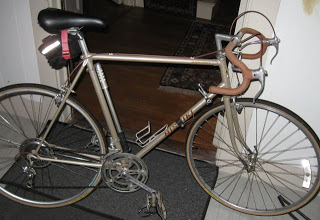
Martine hiking on the Wapack Trail
Shortly after I bought a new bicycle in New Hampshire, I decided to go on a bike ride. I think it was still the 4th of July, the same day the bike shop was inexplicably open for me to buy the bike. A few miles later as I climbed up a hill, I had a flat tire. Bah.
Luckily I found dad’s patch kit, and hacked the pump into working well enough for Presta valve stems instead of Schrader valve stems. It was enough to get me home, but not enough to inspire confidence for a longer ride. A close examination determined that I needed a new rim liner: the one that came with the bike was unsuitable for double walled rims.
After the stores opened up and I got the needed supplies, I set out again on Wednesday. This time, I was bound for the top of Pack Monadnock, a small peak nearby.
This whole “peak” thing may require a bit of explanation for those of you who live way out West in the Pittsburgh area. Unlike here, New England has peaks instead of just ridges. Even where there are a lot of hills in Pittsburgh, none of them lead to a distinct high point with a scenic view in all directions, topped by Big Sky. Peaks provide a much greater sense of accompishment than ridges and rolling hills.
And so it was that I set off towards Pack Monadnock, south summit. My route took me primarily on back roads, and I very quickly realized another difference between cycling in New Hampshire and cycling in Pittsburgh. In the city, I need to go on long rides just to find a little bit of “middle of nowhere.” Even then, I’m really just riding through specially zoned suburbs and not the True middle of nowhere. In New Hampshire, I hit the edge of Nowhere within a few miles. If I lived in New Hampshire I’d probably get lazy, because I wouldn’t have to ride nearly as far to find a nice winding, hilly forest road.
Wait a minute. Where’s my pump? I forgot it! Oops, I probably won’t need it, right?
The day was warm, but the ride was cool and shady under the trees. When I got to Chase Rd. it looked a bit more like an overgrown grassy entrance road to a 200 year old cemetary. Luckily there were a few summer employees there. “This is a through road, right?” “Yep. A bit rocky though, be careful.” Soon it changed from grass to gravel, and then a proper dirt road through the woods.
Next came the first challenging hill. I pretty quickly wished I had my wimpy Pittsburgh gearing, but the Nishiki’s lowest gear was the bike boom standard 40/28. This hill was too soon, I wasn’t warmed up. Or maybe I was out of shape already? Whatever the case may be, I had to rest. Already? How would I ever get up to the top of Pack Monadnock? What a wuss.
The rest of the ride to Miller State Park was uneventful but enjoyable. There were more sections of dirt road, and almost the whole ride was through forests. Just before the park entrance there were a few miles of 8% grade, but that wasn’t too steep. That’s good at least.
Once I entered the park, the road was closed. This was half expected. But bicycles are small, so I decided to see if there was any good reason for the road to be closed or not. It turns out there wasn’t: people were hiking on the road, and a car even came up and passed me on the way.
The last 1.25 miles had about 800 feet of elevation gain, and wasn’t a constant slope. That’s an average grade of around 12%, which is nothing to scoff at. It was hard, and I had to stop several times. Most of the time it didn’t feel as steep as the Dirty Dozen hills I’ve done around here, but it was longer than most of them, and I had a much higher low gear.
I got to the top, looked around, and then went back down. I continued on Route 101 for a while, down the 9% grade on the other side, and missed my intended turn onto Mountain Rd. That turned out to be a good thing, because Mountain Road was another tiny dirt road which was much hillier than the route I ended up taking, and I was basically out of water at this point.
The first store I hit was in Temple, where I got some liquid and energy, and continued on. Eventually it started raining a bit. It was enough to earn me a skunk stripe and remind me why all my bikes have fenders, but not enough to soak me through from the top.
In the end I rode about 40 miles, and had a great time. I didn’t need the pump, which is good because I didn’t have tire levers either. I did have a cell phone, but I’m not sure I had any coverage where I was riding. The only technical problem I had was easy to fix: the clamp-on downtube shifters were apparently a bit loose and slid down the downtube.
 A few days later, we drove out and hiked to the top with Grandpa and the kids. This time I wasn’t riding a bike, but I was on very rocky trails with Ezra on my back. We took the steeper, rocky Wapack trail on the way up, and the tamer Marion Davis trail on the way down. As usual, we came across several stone walls. Even way out here in the middle of nowhere, halfway up a difficult rocky forested slope, the land was once cleared and used for the grazing of cattle. The trees have grown back across much of New Hampshire over the last few hundred years, but I bet the originals were much larger.
A few days later, we drove out and hiked to the top with Grandpa and the kids. This time I wasn’t riding a bike, but I was on very rocky trails with Ezra on my back. We took the steeper, rocky Wapack trail on the way up, and the tamer Marion Davis trail on the way down. As usual, we came across several stone walls. Even way out here in the middle of nowhere, halfway up a difficult rocky forested slope, the land was once cleared and used for the grazing of cattle. The trees have grown back across much of New Hampshire over the last few hundred years, but I bet the originals were much larger.
This was also a very good trip, and I’m glad we did it. It was good to get Martine out in the woods, that’s usually difficult. She did a good job of keeping up with us on the hike, and then she was full of energy for the rest of the afternoon when we got back.

Mount Monadnock, from the summit of South Pack Monadnock
Going up Pack Monadnock stood out as one of the most enjoyable parts of our trip to New Hampshire, I’m glad we decided to do it. Maybe next time we go out, the kids will be old enough to get up Mount Monadnock, which has several miles more hiking along its shortest route. Both of these are small mountains compared to the presidential range in the North, but they’re accessible and very scenic, and that counts for a lot when we have kids in tow.





